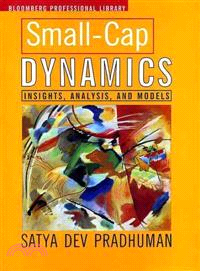SMALL-CAP DYNAMICS: INSIGHTS, ANALYSIS, MODELS
商品資訊
ISBN13:9781576600290
出版社:JOHN WILEY & SONS;LTD
作者:PRADHUMAN
出版日:2000/09/01
裝訂/頁數:精裝/352頁
定價
:NT$ 2468 元優惠價
:90 折 2221 元
絕版無法訂購
商品簡介
作者簡介
目次
相關商品
商品簡介
Small-cap stocks have long been instrumental in profitable portfolios, offering many attractive fundamentals. But without sound knowledge and a risk-wise strategy, red chips can be dangerous turf. In the case of small caps in particular, the confluence of information and market timing is critical. Wall Street strategist Satya Dev Pradhuman here provides his insights and tools, directing professional investors to more successfully navigate in the small-cap environment. As the director of small-cap research at Merrill Lynch, and an oft-quoted top-tier authority in the field, Pradhuman is a voice other market professionals depend on for reliable analysis of this segment. Small-Cap Dynamics is his definitive guidebook. It explains the nature of small-cap cycles and why investors have favored small stocks over the long term. It also elucidates the dynamic issues driving this market sector as well as the dramatic shifts that occur as small stocks evolve into large stocks--and how investors can capitalize on these shifts. Thoroughly illustrated with useful charts and graphs throughout, the book provides practical advice on market timing small stocks according to key risk indicators, the ins and outs of small-cap benchmarks, and guidelines for examining and stress-testing stock selection models, plus much more. This volume is a timely, accessible, and comprehensive resource that will benefit all who seek investment wisdom in this immensely fascinating and significant market segment.
作者簡介
Satya Dev Pradhuman, currently CEO of Cirrus Research LLC, was the director of small-cap research at Merrill Lynch. He had been regularly named as a top ranking analyst in the Institutional Investor magazine. Previously, he was a quantitative strategist focusing on U.S. equity and equity derivative-related strategies at Merrill Lynch. Prior to 1989, he worked as an analyst in the research departments at E.F. Hutton and Lehman Brothers. Pradhuman is widely quoted in the financial press on the topic of small caps.
目次
Preface.
PART I: Fundamentals of the Secondary Market.
Chapter One: Small Stocks and the Relevance of Size.
Why Investors Have Favored Small Stocks.
Classic Small-Cap Types.
Small-Cap Cycles Tend to Be Severe.
Size Rotations from Small Caps to Large Caps.
The Domino Effect.
Preference of Large-Cap Active Investors for Small-Cap Cycles.
How Much Is the Size Factor Worth, and to Whom?
Four Primary Factors Influencing Small-Cap Performance.
Benchmark Definitions.
Chapter Two: The Small-Cap Backdrop.
Microstructure of Equity Markets.
Defining a Company's Size by Its Market Capitalization.
Implications of Unevenly Distributed Market.
Characteristics of the Small-Cap Market.
Small-Cap Benchmarks.
Four Conditions Supporting Small-Cap Asset Class.
A More Delineated Investing Landscape.
Chapter Three: Major Small-Cap and Large-Cap Cycles.
Cycle 1--A Period of Extremes (December 1925-May 1932).
Cycle 2--A Time to Rebuild (June 1932-February 1937).
Cycle 3--The Winds of War (March 1937-December 1939).
Cycle 4--The War Years (January 1940-May 1946).
Noncycle--The Post-War Era (June 1946-November 1964).
Cycle 5--The Vietnam Era (December 1964-December 1968).
Cycle 6--The Complex Years (January 1969-November 1973).
Cycle 7--The Ravages of Inflation (December 1973-July 1983).
Cycle 8--The Go-Go Eighties (August 1983-October 1990).
Cycle 9--The Transition Period (November 1990-December 1993).
Cycle 10--Global Franchises and the Goldilocks Economy (January 1994-January 2000).
Chapter Four: A Changing Landscape--Significant Recent Trends Affecting the Small-Cap Market.
Influence of Technology and the Internet.
Greater Access to Capital for Small Caps.
Institutional Investing.
Increased Aggressiveness of Large Corporations.
Use of Options, Futures, and Other Financial.
Engineering Techniques.
PART II: Navigating in the Small-Cap Universe.
Chapter Five: Asset Allocation and Small Caps.
Using the Asset Allocation Model to Yield an Efficient Portfolio.
Applying an Asset Allocation Framework to Small Stocks.
Small Stocks and the Equity Equation: What Proportion Makes Sense?
The Increasing Relevance of Asset Allocation by Size.
Global Diversification.
The Dollar and the Small-Cap Cycle.
Exceptions to the Rule.
Small Stock Exposure as a Proportion of the Total Equity Market.
Exposure to Small Caps Over the Long Term.
Time Horizon of Investments.
Probability-of-Loss Approach to Assessing Risk.
Chapter Six: Drivers of Secondary Stocks.
Small Caps Outperform Large: Fact or Fiction?
Static Drivers and the Small-Cap Premium.
Dynamic Drivers.
The Uncertainty Paradox.
Chapter Seven: Market Timing Small Stocks.
Short-Term Indicators and Strategic Factors Compared.
Earnings Signals.
Trading Insights from Insider Transactions.
New Issuance Market and Small-Cap Trends.
Chapter Eight: Stock Selection Models.
Investing Framework.
The Value of Quantitative Models.
Key Considerations in Small-Cap Models.
Momentum Investing Models.
Earnings Expectations Models.
Valuation Models.
The Size Effect.
A Multifactor Small-Cap Model.
Chapter Nine: Style Investing.
Investment Style-Growth, Value, and the Style Cycle.
Growth or Value Orientation: The Psychological Factor.
Measuring Investment Styles.
Structuring a Style Model.
Methodology Considerations.
Notes.
Chapter Ten: The January Effect: A Seasonal Premium.
January Effect Defined.
A Market Anomaly.
Potential Drivers of the Seasonal Effect.
Small-Cap Rebound and Large-Cap Market.
Other Drivers.
Confluence of Factors Leading to January Effect.
January Effect as a Value Effect.
December Effect for Growth Stocks.
Capitalizing on the Seasonal Bias
Notes.
Index.
PART I: Fundamentals of the Secondary Market.
Chapter One: Small Stocks and the Relevance of Size.
Why Investors Have Favored Small Stocks.
Classic Small-Cap Types.
Small-Cap Cycles Tend to Be Severe.
Size Rotations from Small Caps to Large Caps.
The Domino Effect.
Preference of Large-Cap Active Investors for Small-Cap Cycles.
How Much Is the Size Factor Worth, and to Whom?
Four Primary Factors Influencing Small-Cap Performance.
Benchmark Definitions.
Chapter Two: The Small-Cap Backdrop.
Microstructure of Equity Markets.
Defining a Company's Size by Its Market Capitalization.
Implications of Unevenly Distributed Market.
Characteristics of the Small-Cap Market.
Small-Cap Benchmarks.
Four Conditions Supporting Small-Cap Asset Class.
A More Delineated Investing Landscape.
Chapter Three: Major Small-Cap and Large-Cap Cycles.
Cycle 1--A Period of Extremes (December 1925-May 1932).
Cycle 2--A Time to Rebuild (June 1932-February 1937).
Cycle 3--The Winds of War (March 1937-December 1939).
Cycle 4--The War Years (January 1940-May 1946).
Noncycle--The Post-War Era (June 1946-November 1964).
Cycle 5--The Vietnam Era (December 1964-December 1968).
Cycle 6--The Complex Years (January 1969-November 1973).
Cycle 7--The Ravages of Inflation (December 1973-July 1983).
Cycle 8--The Go-Go Eighties (August 1983-October 1990).
Cycle 9--The Transition Period (November 1990-December 1993).
Cycle 10--Global Franchises and the Goldilocks Economy (January 1994-January 2000).
Chapter Four: A Changing Landscape--Significant Recent Trends Affecting the Small-Cap Market.
Influence of Technology and the Internet.
Greater Access to Capital for Small Caps.
Institutional Investing.
Increased Aggressiveness of Large Corporations.
Use of Options, Futures, and Other Financial.
Engineering Techniques.
PART II: Navigating in the Small-Cap Universe.
Chapter Five: Asset Allocation and Small Caps.
Using the Asset Allocation Model to Yield an Efficient Portfolio.
Applying an Asset Allocation Framework to Small Stocks.
Small Stocks and the Equity Equation: What Proportion Makes Sense?
The Increasing Relevance of Asset Allocation by Size.
Global Diversification.
The Dollar and the Small-Cap Cycle.
Exceptions to the Rule.
Small Stock Exposure as a Proportion of the Total Equity Market.
Exposure to Small Caps Over the Long Term.
Time Horizon of Investments.
Probability-of-Loss Approach to Assessing Risk.
Chapter Six: Drivers of Secondary Stocks.
Small Caps Outperform Large: Fact or Fiction?
Static Drivers and the Small-Cap Premium.
Dynamic Drivers.
The Uncertainty Paradox.
Chapter Seven: Market Timing Small Stocks.
Short-Term Indicators and Strategic Factors Compared.
Earnings Signals.
Trading Insights from Insider Transactions.
New Issuance Market and Small-Cap Trends.
Chapter Eight: Stock Selection Models.
Investing Framework.
The Value of Quantitative Models.
Key Considerations in Small-Cap Models.
Momentum Investing Models.
Earnings Expectations Models.
Valuation Models.
The Size Effect.
A Multifactor Small-Cap Model.
Chapter Nine: Style Investing.
Investment Style-Growth, Value, and the Style Cycle.
Growth or Value Orientation: The Psychological Factor.
Measuring Investment Styles.
Structuring a Style Model.
Methodology Considerations.
Notes.
Chapter Ten: The January Effect: A Seasonal Premium.
January Effect Defined.
A Market Anomaly.
Potential Drivers of the Seasonal Effect.
Small-Cap Rebound and Large-Cap Market.
Other Drivers.
Confluence of Factors Leading to January Effect.
January Effect as a Value Effect.
December Effect for Growth Stocks.
Capitalizing on the Seasonal Bias
Notes.
Index.
主題書展
更多
主題書展
更多書展今日66折
您曾經瀏覽過的商品
購物須知
外文書商品之書封,為出版社提供之樣本。實際出貨商品,以出版社所提供之現有版本為主。部份書籍,因出版社供應狀況特殊,匯率將依實際狀況做調整。
無庫存之商品,在您完成訂單程序之後,將以空運的方式為你下單調貨。為了縮短等待的時間,建議您將外文書與其他商品分開下單,以獲得最快的取貨速度,平均調貨時間為1~2個月。
為了保護您的權益,「三民網路書店」提供會員七日商品鑑賞期(收到商品為起始日)。
若要辦理退貨,請在商品鑑賞期內寄回,且商品必須是全新狀態與完整包裝(商品、附件、發票、隨貨贈品等)否則恕不接受退貨。
























